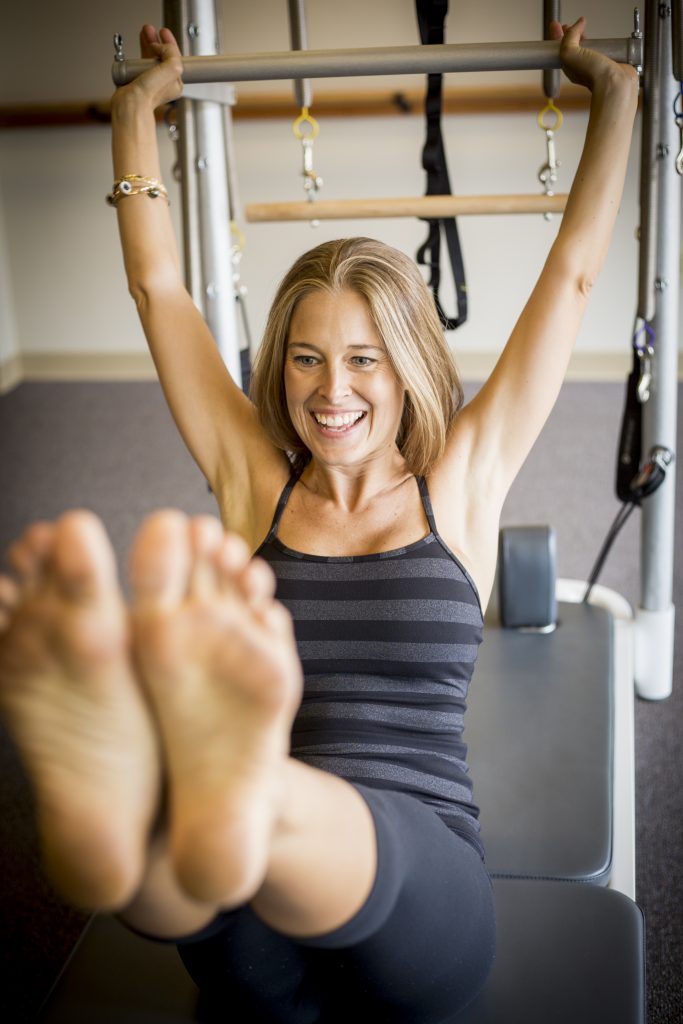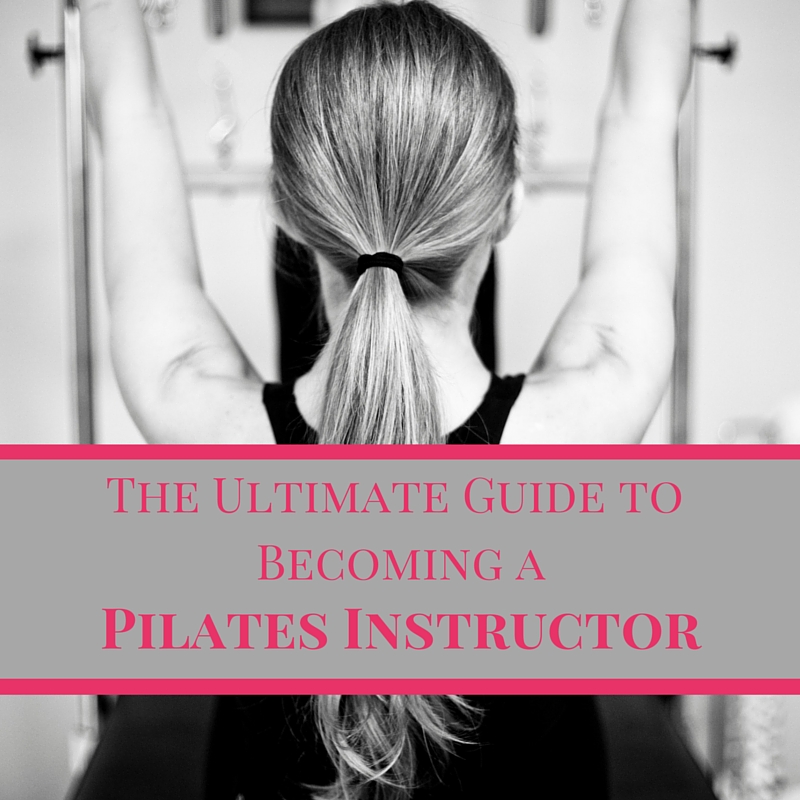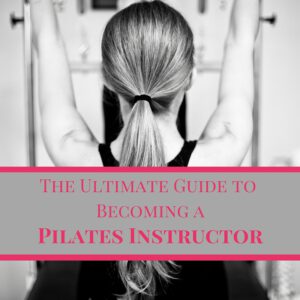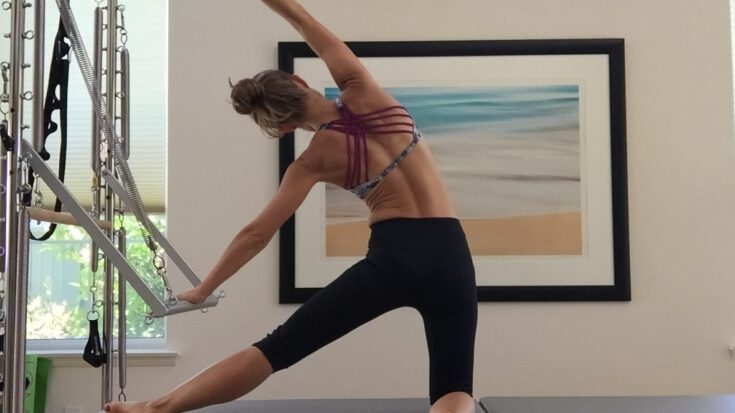I love talking to people about getting a Pilates certification and becoming a Pilates instructor. It is one of the best things I’ve ever done for myself and my career, and I would encourage anyone to follow their passion if it is leading them in this direction.
That being said, the road to getting a Pilates certification can be a little unclear at times.
I am regularly asked questions about how to become a Pilates teacher, what teacher training program to go through and how to become certified.
These are all really important questions and vital things to understand before becoming a Pilates instructor. Unfortunately, there isn’t a lot of information out there that answers these questions easily and clearly.
Because of this, I attempted to put everything in one place for anyone interested in getting a Pilates certification. I hope this handbook helps guide you through the process of deciding if being a Pilates teacher is right for you!
I’ve put the info in a Frequently Asked Questions format for the purpose of this post. If you are interested in receiving future emails and information I save for Pilates teachers, fitness instructors and health care professionals, click here to be added to my email list!
The Pilates Certification Handbook
How do I chose a Pilates teacher training program?
There are countless Pilates programs out there to choose from. Most of them are considered “teacher training programs” as opposed to “schools”. The only ones able to call themselves schools are the ones that have actually gone through their state’s licensure program to become an educational institution. So in general, I would use the term “teacher training program” instead of school.
While there are definitely some shady places offering Pilates training, most of the teacher training programs you will find are reputable and very good. I would first look for programs that support the Pilates Method Alliance (PMA). That is our industry group and they work to help keep the industry professional and full of integrity. You also want a program that requires a combination of classroom hours, observation hours, teaching hours and a test.
If you can take a weekend course and test out in ten minutes at the end, it is not a good Pilates teacher training program.
Once you’ve determined they are reputable, just look through their brochures and get a feeling for their style. Where are they located? Do the dates and times work for you? Do they required you to pay to do apprentice hours with them or are you able to do those at a studio of your choice? Do they have a cancellation policy? If they are a classical teacher training program, are you familiar with that type of movement?
I would find a program that works for your needs and personality. If you need a starting place, go to the Registry of Schools on the PMA website here. That will give you some ideas of places that have top notch training programs.
For the history of why there are different Pilates teacher training programs, read my post here.
Should I teach Pilates mat or equipment?
Every good Pilates teacher training program I know of starts with mat training. It is imperative to have the understanding of the mat work before going to to teach the equipment. Most programs will offer this and then allow you to transition in to their equipment program.
If you have a mat training from another program and want to switch, many will offer a “bridge” program and let you do that as well.
Because of this, I tell anyone interested to go ahead and get your mat training done. After that is when you will want to decide whether to go on and do your equipment training.

A lot of it will have to do with finances (typical mat programs run $800-$1000, while equipment training will cost you over $2000) and whether you want to pursue Pilates as a career option or a hobby. If you want to teach only a couple hours a week, out of your home or in your local small gym, a mat certificate is usually enough.
If you want to teach in various studios, offer private lessons and really brand yourself as a Pilates instructor, you will need to go on and get your equipment training as well.
How do I graduate?
This will be determined by the teacher training program you choose.
A typical complete Pilates training program involves a minimum of 450 hours. This includes class time (usually 60-90 hours) and then a combination of observation hours, apprentice teaching hours and practice hours. This can take anywhere from 6-12 months. After this is completed, you turn in your hours and take your test with your teacher training program.
Most tests include a written portion and an assessment portion. The assessment includes you teaching in various conditions and your instructor watching and grading.
Yes, it is as nerve wracking as it sounds :).
Keep in mind that, at this point, you have really gotten to know your teacher trainer. Class sizes are small and intimate and your instructor WANTS you to succeed. You will be encouraged and supported along the way, so that you feel ready when the time comes to test!
Am I Pilates certified when I finish the program?
Now this is a complicated question, so stay with me.
You are not officially “certified” when you finish your individual teacher training program.
You get either a certificate or diploma and you are able to call yourself a Pilates instructor or Pilates teacher. But you aren’t actually “certified” until you take the PMA’s third-party certification exam.
You can still teach without that certification. There are no laws or rules that say you can’t. There are thousands of Pilates instructors who have chosen not to take the certification exam, and many of them are very good.
It’s a choice to take it and get that “certified” title added to your name.
It adds a level of credibility and professionalism, but it is not required in order to teach Pilates.
I think of it this way. When I graduated from physical therapy school, I received my diploma because I fulfilled all their requirements. I didn’t become an actual licensed physical therapist until I took my state exam and fulfilled THEIR requirements.
The difference is that I couldn’t legally practice PT without paying the state exam and you can teach Pilates without taking the PMA certification.
This is not something you have to decide now or even really understand. Just know that when you finish your teacher training program, you will not call yourself “certified”. You will say you are a Pilates instructor, which is still amazing. Then set a goal for yourself to take the PMA exam after you graduate so you can add that extra badge of having a Pilates certification.
For more information about the history of this concept in the Pilates world, see my post here.
How do I get hired?
Just like you get hired for any other job :). You apply and send in your resume and you interview. You often will be asked to do a teaching demonstration as a part of your interview, and your teacher training diploma may be confirmed with the program you attended.
If you have a teacher training diploma from a smaller or little known school, don’t worry! I’ve interviewed dozens of Pilates instructors over the past 15 years, and the most important things to me are always the in person interview, teaching experience and teaching style. If the diploma was from a school I didn’t know, I would simply look it up online to make sure it was real and had a good program.
How much does a typical Pilates instructor make?
Studios either pay a flat rate per hour, a commission percentage per student or a combination of both. It varies so much across the globe I would hate to narrow down a number here. If you are really curious, just reach out to instructors you know and ask. I have people email me regularly and ask and I give them the best answer I can at the time.
What is the job really like?
Pilates has changed my life and I can’t imagine doing anything else! I became trained shortly after graduating from PT school, and the combination of the two modalities has shaped everything I’ve done since. I have made a full time career out of it because I’ve been willing to work in various studios, see clients in many different settings and market myself.

It’s fun, it’s interesting, it’s never boring, it keeps you moving and you can help change lives.
That being said, most people have a hard time finding 40 hours of clients a week unless they own their own studio or have a separate skill set to add. If you are a chiropractor, massage therapist or physical therapist wanting to add Pilates to your skill set, I think it can be a HUGE boost to your marketability, especially with all of the changes in health care happening. You can simply add it to the services you are already offering.
If you are simply someone who loves Pilates and wants to start a new career path, I think it’s a great opportunity for you as well! What makes a good teacher is passion more than anything else. It allows you to set your own hours, work part time if you chose and even keep your day job :). Even though you might not want to once you start on this amazing path!
I truly hope this Pilates Certification Handbook helped clear up some common questions surrounding the Pilates teacher training process. If you are a Pilates teacher, fitness instructor, health care professional or are striving to be one of these things, sign up for my email list here. I’ll keep you updated about changes in our industry and future classes and courses offered.






I never knew about the PMA certification to be officially considered certified. I do say I’m a certified Balanced Body Mat Pilates Instructor.
Laura – I know it can be confusing! Balanced Body and most of the big Pilates schools have all agreed to stop using the term “certified” unless someone is officially certified through the PMA. So you are a graduate of the Balanced Body program, but only officially “certified” when you take the PMA test and pass it (which is completely voluntary) :).
seriously 4 years later and this is the MOST informed post I’ve seen . thank you..its terribly overwhelming finding help w/ programs